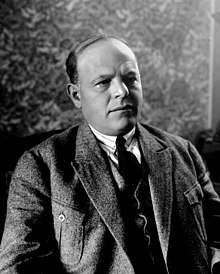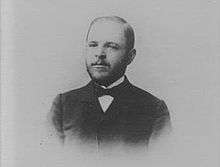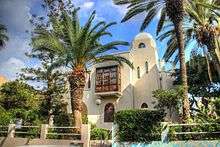Hayim Nahman Bialik
Hayim Nahman Bialik (Hebrew: חיים נחמן ביאליק; January 9, 1873 – July 4, 1934), also Chaim or Haim, was a Jewish poet who wrote primarily in Hebrew but also in Yiddish. Bialik was one of the pioneers of modern Hebrew poetry. He was part of the vanguard of Jewish thinkers who gave voice to the breath of new life in Jewish life.[1] Although he died before Israel became a state, Bialik ultimately came to be recognized as Israel's national poet.
Chayyim Nahman Bialik | |
|---|---|
 Hayyim Nahman Bialik, 1923 | |
| Born | January 9, 1873 Ivnitsa, Volhynian Governorate, Russian Empire |
| Died | July 4, 1934 (aged 61) Vienna, Austria |
| Occupation | Poet, journalist, Children's writer, Translator |
| Literary movement | Hovevei Zion |
Biography

_Bialik_in_1925.jpg)
Bialik was born in Ivnitsa, Volhynian Governorate in the Russian Empire to Itzik-Yosef Bialik, a scholar and businessman from Zhitomir, and his wife, Dinah-Priveh.[2] He had older brother Sheftel (born in 1862) and sister Chenya-Ides (born in 1871), as well as a younger sister Blyuma (born in 1875).[3] When Bialik was still a child, his father died. In his poems, Bialik romanticized the misery of his childhood, describing seven orphans left behind—though modern biographers believe there were fewer children, including grown step-siblings who did not need to be supported. Be that as it may, from the age 7 onwards Bialik was raised in Zhitomir by his Orthodox grandfather, Yankl-Moishe Bialik.
In Zhitomir he received a traditional Jewish religious education, but also explored European literature. At the age of 15, inspired by an article he read, he convinced his grandfather to send him to the Volozhin Yeshiva in Lithuania, to study at a famous Talmudic academy under Rabbi Naftali Zvi Yehuda Berlin, where he hoped he could continue his Jewish schooling while expanding his education to European literature as well. Attracted to the Jewish Enlightenment movement (Haskala), Bialik gradually drifted away from yeshiva life. There is a story in the biography of Rabbi Chaim Solevetchik that cites an anonymous student reputed to be him. The story goes that Rabbi Chaim, after expelling Bialik from the yeshiva for being involved in the Haskala movement, personally escorted his former student out. When asked "Why?" the rabbi replied that he spent the time convincing Bialik not to use his writing talents against the yeshiva world. Poems such as HaMatmid ("The Talmud student") written in 1898, reflect Bialik's great ambivalence toward that way of life: on the one hand admiration for the dedication and devotion of the yeshiva students to their studies, on the other hand a disdain for the narrowness of their world.
At 18 he left for Odessa, the center of modern Jewish culture in the southern Russian Empire, drawn by such luminaries as Mendele Mocher Sforim and Ahad Ha'am. In Odessa, Bialik studied Russian and German language and literature and dreamed of enrolling in the Modern Orthodox Rabbinical Seminary in Berlin. Alone and penniless, he made his living teaching Hebrew. The 1892 publication of his first poem, El Hatzipor "To the Bird", which expresses a longing for Zion, in a booklet edited by Yehoshua Ravnitzky (1859-1944) (a future collaborator), eased Bialik's way into Jewish literary circles in Odessa. He joined the Hovevei Zion movement and befriended Ahad Ha'am, who had a great influence on his Zionist outlook.
In 1892 Bialik heard news that the Volozhin Yeshiva had closed and returned home to Zhitomir to prevent his grandfather from discovering that he had discontinued his religious education. He arrived to find both his grandfather and his older brother close to death. Following their deaths, Bialik married Manya Averbuch[4] in 1893. For a time he served as a bookkeeper in his father-in-law's lumber business in Korostyshiv, near Kiev. But when this proved unsuccessful, he moved in 1897 to Sosnowiec, a small town in Zaglebie, southern Poland, which was then part of the Russian Empire, near the border with Prussia and Austria. In Sosnowiec, Bialik worked as a Hebrew teacher and tried to earn extra income as a coal merchant, but the provincial life depressed him. He was finally able to return to Odessa in 1900, having secured a teaching job.
Bialik's first visit to the US was to Hartford, CT, where he stayed with Cousin Raymond Bialeck and his family. His closest living relatives in the US include Hal Bialeck, Alison Bialeck and Richard Bialeck. He is the uncle of actress Mayim Bialik's great-great-grandfather.[5]
Literary career

For the next two decades, Bialik taught and continued his activities in Zionist and literary circles, as his literary fame continued to rise. This is considered Bialik's "golden period". In 1901 his first collection of poetry was published in Warsaw, and was greeted with much critical acclaim, to the point that he was hailed "the poet of national renaissance." Bialik relocated to Warsaw briefly in 1904 as literary editor of the weekly magazine HaShiloah founded by Ahad Ha'am, a position he served for six years.
In 1903 Bialik was sent by the Jewish Historical Commission in Odessa to interview survivors of the Kishinev pogroms and prepare a report. In response to his findings Bialik wrote his epic poem "In the City of Slaughter", a powerful statement of anguish at the situation of the Jews. Bialik's condemnation of passivity against anti-Semitic violence is said to have influenced the founding Jewish self-defense groups in the Russian Empire, and eventually the Haganah in Palestine. Bialik visited Palestine in 1909.
It was during this 1903 visit to Odessa that Bialik first met Ira Jan[6], the painter whom he secretly loved, as revealed by Prof. Ziva Shamir in her book "A Track of Her Own".[7]
In the early 20th century, together with Ravnitzky, Simcha Ben Zion and Elhanan Levinsky, Bialik founded a Hebrew publishing house, Moriah, which issued Hebrew classics and school texts. He translated into Hebrew various European works, such as Shakespeare's Julius Caesar, Schiller's Wilhelm Tell, the Miguel de Cervantes novel Don Quixote, and Heine's poems; and from Yiddish S. Ansky's The Dybbuk.
Throughout the years 1899–1915, Bialik published about 20 of his Yiddish poems in different Yiddish periodicals in the Russian Empire. These poems are often considered to be among the best achievements of modern Yiddish poetry of that period. In collaboration with Ravnitzky, Bialik published Sefer HaAggadah (1908–1911, The Book of Legends), a three-volume edition of the folk tales and proverbs scattered through the Talmud. For the book they selected hundreds of texts and arranged them thematically. The Book of Legends was immediately recognized as a masterwork and has been reprinted numerous times. Bialik also edited the poems of the medieval poet and philosopher Ibn Gabirol. He began a modern commentary on the Mishnah, but only completed Zeraim, the first of the six Orders (in the 1950s, the Bialik Institute published a commentary on the entire Mishnah by Hanoch Albeck, which is currently out of print). He also added several commentaries on the Talmud.
In 1919 in Odessa, he was also able to found the Dvir publishing house, which would later become famous.[8][9] This publishing house, now based in Israel, still exists, but is now known as Kinneret Zmora-Bitan Dvir after Dvir was purchased by the Zmora-Bitan publishing house in 1986, which later merged with Kinneret.
Bialik lived in Odessa until 1921, when the Moriah publishing house was closed by Communist authorities, as a result of mounting paranoia following the Bolshevik Revolution. With the intervention of Maxim Gorki, a group of Hebrew writers were given permission by the Soviet government to leave the country. While in Odessa he had befriended the soprano Isa Kremer whom he had a profound influence on. It was through his influence that she became an exponent of Yiddish music on the concert stage; notably becoming the first woman to concertize that music.
Move to Germany
Bialik then moved, via Poland and Turkey, to Berlin, where together with his friends Ravnitzky and Shmaryahu Levin he re-established the Dvir publishing house. Bialik published in Dvir the first Hebrew language scientific journal with teachers of the rabbinical college Hochschule für die Wissenschaft des Judentums contributing. In Berlin Bialik joined a community of Jewish authors and publishers such as Samuel Joseph Agnon (sponsored by the owner of Schocken Department Stores, Salman Schocken, who later founded his own publishing house), Simon Dubnow, Israel Isidor Elyashev (Ba'al-Machshoves), Uri Zvi Greenberg, Jakob Klatzkin (founded Eschkol publishing house in Berlin), Moshe Kulbak, Jakob-Wolf Latzki-Bertoldi (founded Klal publishing house in Berlin in 1921), Simon Rawidowicz (co-founder of Klal), Salman Schneur, Nochum Shtif (Ba'al-Dimion), Shaul Tchernichovsky, elsewhere in Germany Shoshana Persitz with Omanuth publishing house in Bad Homburg v.d.H. and Martin Buber. They met in the Hebrew Club Beith haWa'ad ha'Ivri בית הועד העברי in Berlin's Scheunenviertel, or in Café Monopol, which had a Hebrew-speaking corner, as Eliezer Ben-Yehuda's son Itamar Ben-Avi recalled, and in Café des Westens (both in Berlin's more elegant western boroughs).
The still-Soviet theatre HaBimah toured through Germany, much-acclaimed by Albert Einstein, Alfred Kerr and Max Reinhardt. Bialik succeeded Saul Israel Hurwitz after his death on 8 August 1922 as Hebrew chief editor at Klal publishing house, which published 80 titles in 1922.[10] On January 1923 Bialik's 50th birthday was celebrated in the old concert hall of the Berlin Philharmonic bringing together everybody who was anybody.[11] In the years of Inflation Berlin had become a centre of Yiddish and Hebrew and other foreign language publishing and printing, because books could be produced at ever falling real expenses and sold to a great extent for stable foreign currency. Many Hebrew and Yiddish titles were also translated into German. Once the old inflationary currency (Mark) was replaced by the new stable Rentenmark and Reichsmark this period ended and many publishing houses closed or relocated elsewhere, as did many prominent publishers and authors.
Move to Tel Aviv


In 1924, Bialik relocated with his publishing house Dvir to Tel Aviv, devoting himself to cultural activities and public affairs. Bialik was immediately recognized as a celebrated literary figure. He delivered the address that marked the opening (in 1925) of the Hebrew University in Jerusalem and was a member of its board of governors. In 1927 he became head of the Hebrew Writers Union, a position he retained for the remainder of his life. In 1933 his 60th birthday was celebrated with festivities nationwide, and all the schoolchildren of Tel Aviv were taken to meet him and pay their respects to him.
Works and influence
Bialik wrote several different modes of poetry. He is perhaps most famous for his long, nationalistic poems, which call for a reawakening of the Jewish people. Bialik had his own awakening even before writing those poems, arising out of the anger and shame he felt at the Jewish response to pogroms. In his poem "Massa Nemirov", for example, Bialik excoriated the Jews of Kishinev who had allowed their persecutors to wreak their will without raising a finger to defend themselves.[12]

However no less effective are his passionate love poems, his personal verse, or his nature poems. Last but not least, Bialik's songs for children are a staple of Israeli nursery life. From 1908 onwards, he wrote mostly prose.
By writing his works in Hebrew, Bialik contributed significantly to the revival of the Hebrew language, which before his days existed primarily as an ancient, scholarly tongue. His influence is felt deeply in all modern Hebrew literature. The generation of Hebrew language poets who followed in Bialik's footsteps, including Jacob Steinberg and Jacob Fichman, are called "the Bialik generation".
To this day, Bialik is recognized as Israel's national poet. Bialik House, his former home at 22 Bialik Street in Tel Aviv, has been converted into a museum, and functions as a center for literary events. The municipality of Tel Aviv awards the Bialik Prize in his honor. Kiryat Bialik, a suburb of Haifa, and Givat Hen, a moshav bordering the city of Raanana, are named after him. He is the only person to have two streets named after him in the same Israeli city – Bialik Street and Hen Boulevard in Tel Aviv. There is also Bialik Hebrew Day School in Toronto, ON, Canada;[13] Bialik High School in Montreal, QC, Canada; and a cross-communal Jewish Zionist school in Melbourne called Bialik College. In Caracas, Venezuela, the largest Jewish community school is named Herzl-Bialik. Also in Rosario, Argentina the only Jewish school is named after him.
Bialik's poems have been translated into at least 30 languages, and set to music as popular songs. These poems, and the songs based on them, have become an essential part of the education and culture of modern Israel.
Bialik wrote most of his poems using "Ashkenazi" pronunciation, while modern Israeli Hebrew uses the Sephardi pronunciation. Consequently, Bialik's poems are rarely recited in the meter in which they were written.
Death
Bialik died in Vienna, Austria, on July 4, 1934, from a sudden heart attack a week after having had a successful prostate operation.[14] He was buried in Tel Aviv; a large mourning procession followed from his home on the street named after him, to his final resting place.
References
- "Heroes – Trailblazers of the Jewish People". Beit Hatfutsot.
- Birth records of both Hayim and Blyuma Byalik are available at JewishGen.org (genealogical database for Ukraine). Date of birth: January 6, 1873. Place of birth: Ivnitsa, Zhitomir district, Volhynian Governorate. Parents: Itsko-Yosef Byalik (son of Yankel-Moyshe Byalik), from Zhitomir, and Dinah-Priva Byalik. His sister Blyuma was born on January 20, 1875, also in Ivnitsa.
- Revision list with all members of the Bialik family in Zhitomir (including Hayim-Nakhman, aged 10) from 1884 is available at JewishGen.org. His father was still alive and 56 years old at the revision, his mother was 51.
- Holtzman, Avner (21 February 2017). "Hayim Nahman Bialik: Poet of Hebrew". Yale University Press – via Google Books.
- "Mayim Bialik: From 'Blossom' to Brachot - Jewcy". Jewcy. 2009-05-06. Retrieved 2018-04-23.
- Bachi Kolodny, Ruth (27 February 2009). "IRA JAN". Jewish Women's Archive. Retrieved 18 October 2019.
- Rotem, Tamar (17 July 2001). "The Flower Is Forgot". Haaretz. Retrieved 19 October 2019.
- "English".
- "Natasha Farrant : Writer & Literary Scout".
- Maren Krüger, 'Buchproduktion im Exil. Der Klal-Verlag', In: Juden in Kreuzberg: Fundstücke, Fragmente, Erinnerungen …, Berliner Geschichtswerkstatt e.V. (ed.), Berlin: Edition Hentrich, pp. 421–426, here p. 422. ISBN 3-89468-002-4
- Michael Brenner, 'Blütezeit des Hebräischen: Eine vergessene Episode im Berlin der zwanziger Jahre', In: Frankfurter Allgemeine Zeitung, 23 September 2000, supplement 'Ereignisse und Gestalten', p. III.
- Katz, Shmuel (1996). Lone Wolf: A Biography of Vladimir Jabotinsky. Barricade Books. pp. 47–48. ISBN 1569800421.
- "Home - Bialik Hebrew Day School". Bialik Hebrew Day School.
- "Bialik dies suddenly" (PDF). Jewish Daily Bulleting (No. 2889). Jewish Telegraphic Agency. 5 July 1934. Retrieved 18 November 2014.
Selected bibliography in English
- Selected Writings (poetry and prose) Hasefer, 1924; New York, New Palestine, 1926; Philadelphia, Jewish Publication Society, 1939; New York, Histadrut Ivrit of America, 1948; New York, Bloch, 1965; New York, Union of American Hebrew Congregations, 1972; Tel Aviv, Dvir and the Jerusalem Post, 1981; Columbus, Alpha, 1987
- The Short Friday Tel Aviv, Hashaot, 1944
- Knight of Onions and Knight of Garlic New York, Jordan, 1939
- Random Harvest – The Novellas of C. N. Bialik, Boulder, Colorado, Westview Press (Perseus Books), 1999
- The Modern Hebrew Poem Itself (2003), ISBN 0-8143-2485-1
- Songs from Bialik: Selected Poems of Hayim Nahman Bialik, Syracuse, Syracuse University Press, 2000
- Selected Poems: Bilingual Edition, (translated by Ruth Nevo), Jerusalem: Dvir, 1981.
External links
![]()
- Biography at the Jewish Virtual Library
- Works by or about Hayim Nahman Bialik at Internet Archive
- Works by Hayim Nahman Bialik at LibriVox (public domain audiobooks)

- Petri Liukkonen. "Hayim Nahman Bialik". Books and Writers
- Hayim Nahman Bialik Personal Manuscripts and Letters